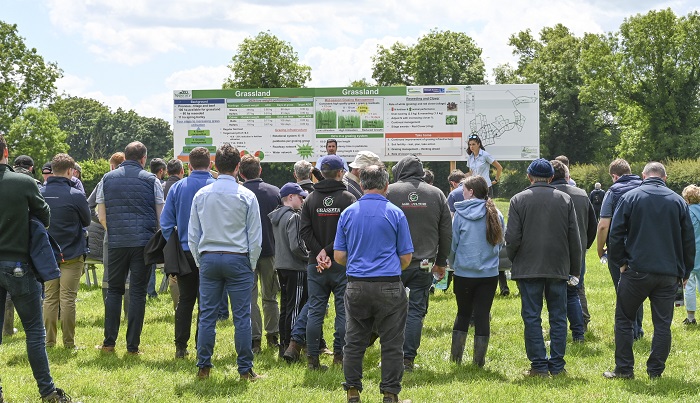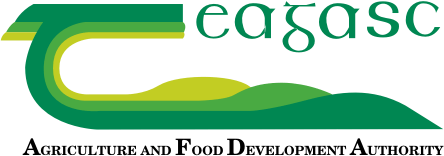28 July 2024
The grassland improvements at the Tipperary Dairy Calf to Beef Demonstration Farm

Chloe Millar, Jack Spillane, Michael Egan and Ciarán Hearn share details of how the Tipperary Dairy Calf to Beef Demonstration Farm has transformed in terms of grassland management since the lease was signed on the venture in 2022.
The 112ha block of land was leased on April 1 2022. At this time approximately 20ha was in grass, while the remaining area had been in tillage (spring barley, spring oats and fodder beet). Since the farm was leased, approximately 12ha per year (2022, 2023 and 2024) has being used to produce spring barley. All other land has been reseeded, with approx. 80ha reseeded over the past 2-3 years.
Farm grazing infrastructure
A lot of grazing infrastructure in the farm has been redeveloped. At the start of the lease in 2022, there was 7km of farm roadways put in across 112ha. There were some existing roadways, which were mostly high quality. Some of the roadways needed upgrading to make them suitable for regularly moving animals. In spring of 2024, 1.5km of the existing roadways were upgraded.
The farm was fenced into 47 paddocks in April 2022. The paddocks are approx. 2.5ha in size. There was previously no water network on the farm; a total of 1.5 km of 45mm water pipe, in addition to 25mm secondary water pipes, was installed in 2022. These pipes service approximately 50 water troughs (690 Litres/150 gallons), with all water troughs positioned centrally in paddocks.
Reseeding and oversowing
The importance of sward renewal is key to ensuring increased levels of herbage production and animal performance. Including white clover in swards increases both animal and herbage and also reduces chemical nitrogen fertiliser requirement. White clover swards can be established successfully by reseeding, using (5kg/ha) of clover with 30kg/ha of perennial ryegrass.
Clover oversowing with 6.5 kg/ha should be carried out in the April and May period, it is important that there is adequate soil moisture post establishment. Post-sowing management is vital for reseeding and oversowing, paddocks should be grazed at low covers, 1,100 kg DM/ha for three/four rotations, heavy cuts of silage should be avoided for the first 12 months.
All the current swards were established with a mixture of perennial ryegrass and white clover. All paddocks reseeded to date have used grass mixtures including high Pasture Profit Index varieties (cv. AberGain, AberChoice, Ballintoy and Ballyvoy; 27 kg/ha)) and medium leaf white clover (cv. Buddy; 5 kg/ha). Any paddock that had a clover content <10% was oversown in April/May the following year.
Soil fertility
Optimal soil fertility is crucial to establishing productive swards. Grass and white clover swards require a soil pH of 6.5 and > Index 3 for P & K, for optimum clover establishment and maximising nitrogen fixation.
There has been major efforts made to improve the soil fertility status over the past two years (Table 1), by targeting slurry and compound fertiliser to paddocks with the greatest requirement. The most recent soil test results indicate that lime is needed on 20.2ha this year to increase the soil pH >6.3. The phosphorus levels on farm have not changed much over the 2-year period, 3% of the farm declined from Index 3 to Index 2; more targeted use of slurry and chemical fertiliser is required to bring the whole farm to a target Index 3 and 4 for phosphorus.
The targeted use of artificial potassium fertiliser over the past two years has increased the area of the farm with optimal levels of soil potassium where 69% of the farm now in Index 3 or 4. Optimising pH, phosphorus and potassium soil status will allow the farm to grow more grass, while maintaining sufficient levels (>20%) of white cover in grazing swards.
Table 1: Area of farm (ha) in each soil fertility category from soil samples taken in 2022 and 2024
| 2022 | 2024 | ||
|---|---|---|---|
| Total area | 104.4 | 104.4 | |
| Soil pH | pH >6.2 | 88% | 81% |
| pH <6.2 | 12% | 19% | |
| K Index | 1 & 2 | 44% | 31% |
| 3 & 4 | 56% | 69% | |
| P Index | 1 & 2 | 44% | 47% |
| 3 & 4 | 56% | 53% | |
Grass grown and grazing management
All grassland data (farm cover, reseeding, fertiliser, etc) is recorded in PastureBase Ireland (PBI). In 2023, the farm grew an average of 12.4t DM/ha (Table 2), 1.9t DM/ha more than the average pasture production on Irish beef farms for 2023.
Relatively low levels of chemical nitrogen (N) fertiliser (70kg N/ha) were spread on the farm in 2023 (Table 4), so this growth can be largely attributed to the high level of reseeding that took place in 2022. To maintain this level of pasture production in 2024, the level of chemical N applied has been increased to date, with a target to apply approximately 150kg/ha while also targeting an average sward white clover content of >20%.
Table 2: Total grazing and silage pasture production (t DM/ha) and defoliation events (grazing and silage) for 2023
| Paddock category |
Grass yield (t DM/ha) |
No. of grazing events |
Grazing yield (t DM/ha) |
No. of silage cuts |
Silage yield (t DM/ha) |
|---|---|---|---|---|---|
| Average | 12.4 | 5.7 | 7.7 | 1.3 | 4.7 |
| PBI top 10% | 16.7 | 5.8 | 8.7 | 1.4 | 8.0 |
| PBI bottom 10% | 7.7 | 5.2 | 6.2 | 0.6 | 1.5 |
Farm walks and grazing covers
A total of 47 farm cover walks were recorded in 2023. Using this data, the grazing season was extended to >300 days (Table 3). The farm was still in a transition period in 2023, with a lower average-stocking rate of 1.85LU/ha. The farm is currently stocked at 2.49LU/ha (Table 4), this stocking rate will require the farm to grow 12-13 t DM/ha/year consistently.
Maintaining pre-grazing yields between the target of 1,200-1,500 kg DM/ha can offer high quality feed to the animals. The pre-grazing yield has been kept low on the farm where newly reseeded paddocks are grazed at lower pre-grazing targets to encourage good tillering of swards – this figure will gradually increase to approximately 1,400 kg DM/ha.
Table 3: Key grassland management performance indicators from the dairy calf to beef research studies across Ireland in 2023
| Key performance indicator | Tipp. Demo Farm | Grange | Johnstown Castle | Teagasc target |
|---|---|---|---|---|
| Farm cover | 47 | 39 | 28 | 30 |
| Days at grass | 300 | 235 | 241 | 280-300 |
| Stocking rate (LU/ha) | 1.85 | 3.0 | 2.31 | 2.5 |
| Magic day | May 3 | May 18 | May 9 | April 20 |
| Average pre-grazing yield (kg DM/ha) | 1,200 | 1,750 | 1,650 | 1,400 |
In 2024, 40ha (38%) of the farm was closed up for silage on April 18 and harvested on May 25. This first-cut silage will provide the bulk of the winter feed supply for the farm. Further silage cuts will be harvested from surplus grass, when there is periods of excess growth over the summer period.
Table 4: Key performance grassland management indicators on the Tipperary Demonstration Farm in 2023 and 2024
| Key performance indicator | 2023 | Year to June 1 2024 |
|---|---|---|
| Farm covers | 47 | 16 |
| Turnout date | January 27 | January 17 |
| Housing date | December 1 | – |
| Chemical N applied | 70kg N/ha | 72kg N/ha |
| Organic N applied | 9kg N/ha | 27kg N/ha (2,500 gallons/ac) |
| % Farm with clover1 | 68% | 70% |
| Stocking rate (LU/ha) | 1.85 | 2.49 |
| Average pre-grazing yield (kg DM/ha) | 1,200 | 1,200 |
1Farm area with 20% sward clover content
Conclusion
The farm has been established to support an intensive grass based dairy calf to beef production system. There has been a strong focus on reseeding and the inclusion of white clover in swards. The key challenge will be to maintain >20% clover in the swards to optimise animal performance. An effective farm roadway network and grazing infrastructure has been established to ensure that a long grazing season can be achieved, as the animals have close access to grass. The farm will be targeted to maintain high animal grazing performance as well as ensuring the farm is self-sufficient for grazing and silage DM production in the years ahead.
